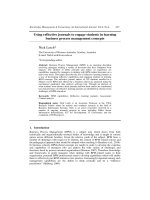SKKN USING LEARNING STATIONS TO ENGAGE STUDENTS AND PROMOTE AUTONOMY IN LEARNING READING SKILLS IN THE NEW ENGLISH TEXTBOOK 10
Bạn đang xem bản rút gọn của tài liệu. Xem và tải ngay bản đầy đủ của tài liệu tại đây (2.23 MB, 43 trang )
TEACHING EXPERIENCE
USING LEARNING STATIONS TO ENGAGE STUDENTS AND
PROMOTE AUTONOMY IN LEARNING READING SKILLS
IN THE NEW ENGLISH TEXTBOOK 10
Scope: Theory and Methods of Teaching English
NGHE AN DEPARTMENT OF TRAINING AND EDUCATION
HOANG MAI 2 HIGH SCHOOL
TEACHING EXPERIENCE
USING LEARNING STATIONS TO ENGAGE STUDENTS AND
PROMOTE AUTONOMY IN LEARNING READING SKILLS
IN THE NEW ENGLISH TEXTBOOK 10
Scope
: Theory and Methods of Teaching English
Author
: Tran Thi Nhan
Specialized Team : Literature - English
Cell phone
: 0964 878 428
School year: 2021 – 2022
TABLE OF CONTEND
PART I: INTRODUCTION ................................................................................ 1
1. Rationale of the study ......................................................................................... 1
2. Aims of the study .............................................................................................. 1
3. Scope of the study .............................................................................................. 1
4. Object of study .................................................................................................. 1
5. Method of the study ........................................................................................... 2
PART II: MAIN CONTENT ............................................................................... 3
1. Theoretical and practical background ........................................................... 3
1.1. Theoretical background ................................................................................... 3
1.1.1 Definition of station ...................................................................................... 3
1.1.2. Factors effecting learning station method ..................................................... 3
1.1.3. Advantages of learning station method ......................................................... 3
1.1.4. Disadvantages of learning station method ..................................................... 4
1.2. Practical background ....................................................................................... 5
2. Solutions ............................................................................................................ 5
2.1. Process of designing and teaching by learning stations .................................... 5
2.1.1 Process of designing lessons by using learning station method ..................... 5
2.1.2 Process of conducting lessons by using learning station method ................... 7
2.2. Designing lesson plans ................................................................................... 7
3. Exploring reading lessons in New English textbook 10 ................................. 9
3.1. Unit 4: For a better community – Lesson: Reading .......................................... 9
3.2. Unit 8: new ways to learn – lesson: reading ................................................... 13
3.3. Unit 9: preserving the environment – lesson: reading .................................... 19
PART III- RESULTS OF THE RESEARCH ......................................................
1. Research evaluation .......................................................................................... 24
2. Achieved results .............................................................................................. 25
PART IV- RESULTS OF THE RESEARCH .................................................. 26
1. Conclusion ....................................................................................................... 26
2. Effectiveness of the research ........................................................................... 26
3. Suggestions for further study ............................................................................ 29
REFERENCES ...................................................................................................... i
APPENDIX ......................................................................................................... ii
SKKN.USING.LEARNING.STATIONS.TO.ENGAGE.STUDENTS.AND.PROMOTE.AUTONOMY.IN.LEARNING.READING.SKILLS.IN.THE.NEW.ENGLISH.TEXTBOOK.10SKKN.USING.LEARNING.STATIONS.TO.ENGAGE.STUDENTS.AND.PROMOTE.AUTONOMY.IN.LEARNING.READING.SKILLS.IN.THE.NEW.ENGLISH.TEXTBOOK.10SKKN.USING.LEARNING.STATIONS.TO.ENGAGE.STUDENTS.AND.PROMOTE.AUTONOMY.IN.LEARNING.READING.SKILLS.IN.THE.NEW.ENGLISH.TEXTBOOK.10SKKN.USING.LEARNING.STATIONS.TO.ENGAGE.STUDENTS.AND.PROMOTE.AUTONOMY.IN.LEARNING.READING.SKILLS.IN.THE.NEW.ENGLISH.TEXTBOOK.10
PART I: INTRODUCTION
1. Rationale of the study
The new general education program in the subject of English of the Ministry
of Education and Training aims at equipping students with communicative
competence, language skills and attitudes. Traditional teacher-centred learning
which focuses on completing tests and examinations instead of enhancing students’
productive skills will no longer be effective in preparing students for new
challenges in the new millennium.
The 21st-century teaching and learning demands educators to change their
practice from a teacher-centred to a more diverse student-centred learning
environment. The notion of student-centred learning originates from the
constructivist theory, which denotes the role of the students as active and central in
the learning process. In a successful student-centred learning environment, students
have greater control of their learning, in which they are allowed to create their own
learning goals, consider strategies, and make decisions to achieve these goals. This
engaging process makes learning more meaningful and promotes higher thinking
skills.
In addition, one of the biggest challenges that teachers face in the classroom is
how to liven lessons, especially reading and writing lessons. I sought to determine
the techniques that would improve students’ motivation and enable students to
develop more language skills as well as complex learning strategies.
The matter above inspired me to deal with the topic: “Using learning stations
to engage students and promote autonomy in English lessons in the new
english textbook 10.”
2. Aims of the study
This study aims at designing activities for reading lessons in new english
textbook 10 to engage learners in learning english, encourage them to focus on the
meaning and function of language rather than specific forms, and promote
students’ autonomy in a fun and interactive environment.
3. Scope of the study
- Applying in the reading, writing and review lessons in English 10
- Applying to get students involve in the lessons
4. Object of study:
- Students in grade 10 at Hoang Mai 2 high school
SKKN.USING.LEARNING.STATIONS.TO.ENGAGE.STUDENTS.AND.PROMOTE.AUTONOMY.IN.LEARNING.READING.SKILLS.IN.THE.NEW.ENGLISH.TEXTBOOK.10SKKN.USING.LEARNING.STATIONS.TO.ENGAGE.STUDENTS.AND.PROMOTE.AUTONOMY.IN.LEARNING.READING.SKILLS.IN.THE.NEW.ENGLISH.TEXTBOOK.10SKKN.USING.LEARNING.STATIONS.TO.ENGAGE.STUDENTS.AND.PROMOTE.AUTONOMY.IN.LEARNING.READING.SKILLS.IN.THE.NEW.ENGLISH.TEXTBOOK.10SKKN.USING.LEARNING.STATIONS.TO.ENGAGE.STUDENTS.AND.PROMOTE.AUTONOMY.IN.LEARNING.READING.SKILLS.IN.THE.NEW.ENGLISH.TEXTBOOK.10
1
SKKN.USING.LEARNING.STATIONS.TO.ENGAGE.STUDENTS.AND.PROMOTE.AUTONOMY.IN.LEARNING.READING.SKILLS.IN.THE.NEW.ENGLISH.TEXTBOOK.10SKKN.USING.LEARNING.STATIONS.TO.ENGAGE.STUDENTS.AND.PROMOTE.AUTONOMY.IN.LEARNING.READING.SKILLS.IN.THE.NEW.ENGLISH.TEXTBOOK.10SKKN.USING.LEARNING.STATIONS.TO.ENGAGE.STUDENTS.AND.PROMOTE.AUTONOMY.IN.LEARN









